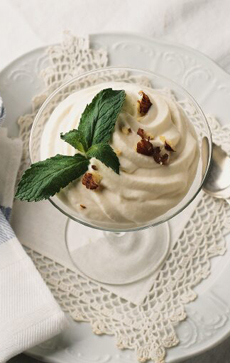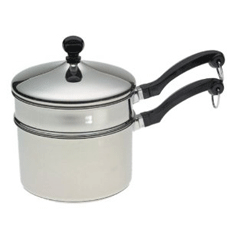
 Mascarpone mousse with hazelnuts. Get the recipe. Photo courtesy Wisconsin Milk Marketing Board. Mascarpone mousse with hazelnuts. Get the recipe. Photo courtesy Wisconsin Milk Marketing Board.
|
STEPHANIE ZONIS focuses on good foods and the people who produce them.
|
|
October 2006
Last Updated February 2012
|
 |
Mascarpone Cheese Recipe
Also Called Mascarpone Cream and Italian Cream Cheesse
This is Page 2 of a two-page article on mascarpone cheese/mascarpone cream. Click on the black links below to visit other pages.
Make Your Own Mascarpone
Mascarpone is a simple cheese to produce, in part because it isn’t pressed or aged.
- Cream is heated, then curdled with an acid.
- The mixture is removed from the heat and allowed to stand for some time, then drained of excess whey.
- That’s about all that goes into making mascarpone. While it takes only 15 minutes to make, it needs to chill for 12 hours in the fridge before use.
- Because mascarpone is a fresh cheese, it should be eaten quickly, within a week of production.
- And because this creamy cheese is more like a topping than a cheese, it is also called mascarpone cream.
If you want to try making your own mascarpone at home, there are innumerable recipes to be found, but there’s little consensus regarding the necessary ingredients.
- Cream. Some recipes specify heavy cream; some insist on light cream. The one point of agreement is that the cream should not be ultrapasteurized (a treatment that extends the shelf life). Cream that’s pasteurized, but not ultrapasteurized, is becoming increasingly difficult to find, but a you should be able to find it at a natural foods store (along with the tartaric acid) or farmers market.
- Acid. For the acid, I’ve seen lemon juice, tartaric acid and white wine vinegar listed as possibilities.
Mascarpone Cheese Recipe
You’ll need a double boiler, a cooking thermometer and heavyweight cheesecloth, along with these ingredients. Ingredients
- 1 quart heavy cream
- 1/4 teaspoon tartaric acid*
*Cream of tartar is not the same as tartaric acid: It is the salt made by neutralizing tartaric acid with potassium hydroxide. Cream of tartar is used for baking, not cheese-making.
|
|

We’ve had this Farberware double boiler for 30 years! Get one. |
Preparation
- Add. Pour cream into a double boiler. If you don’t have one, stack one sauce pan over another.
- Heat. Heat the cream to 180°F; remove from heat. Stir for 30 seconds, remove the top of the double boiler and continue to stir the cream for an additional 2 minutes.
- Add. Stir in the tartaric acid.
- Pour. In a colander or basket lined with heavy cheesecloth, pour in the cream.
- Wait. Let the mascarpone stand for 12 hours in cool place (or the lowest shelf of the fridge).
- Transfer. Cut four 9-inch squares of heavy cheesecloth. Open one onto your work surface. Using a large spoon, transfer 1/4 of the mascarpone to the center of the square; fold each side of the cheesecloth up to make an envelope and place, folded side down, on a large plate or tray. Do the same with the remaining squares.
- Chill. Refrigerate for at least 12 hours before using. Use within one week.
Mascarpone Serving Suggestions
What should you do with your mascarpone?
- As A Savory Spread. Italians enjoy mascarpone as a savory spread, mixed with anchovies, mustard and herbs.
- As A Sweet Spread. We love adding a bit of sweetener to the mascarpone and using it as a spread on plain cookies such as shortbread and tea biscuits. Or simply spread it on good bread, and drizzle it with honey.
- With Fruit. Perhaps the favorite use for mascarpone is slightly sweetened and served with fresh fruit—seasonal berries or figs, for example—or a wine- or Port-poached pear (if you don’t want alcohol, try this recipe poached in cranberry juice or this one simply in lemon juice and water).
- In Sweet Recipes. You can find recipes for mascarpone cheesecakes and other baked delights, as well as elaborate dessert sauces, puddings and ice cream. I’ve also seen it used as a layer cake filling and frosting.
- In Savory Recipes. On the savory side of the culinary spectrum, mascarpone can be used as a butter substitute in risotto recipes, added at the last minute to thicken a risotto and lend an additional richness. And there are numerous recipes for pasta and polenta dishes.
|
|

Mascarpone parfait with crumbled biscotti. Get the recipe. Photo courtesy Wisconsin Milk Marketing Board. |
However you use mascarpone, it’s creamy, delicate nature is sure to please.
Lifestyle Direct, Inc. All rights reserved. Images are the copyright of their respective owners. 
|






